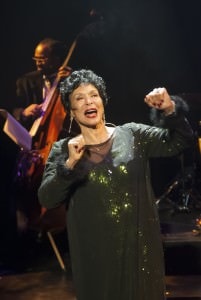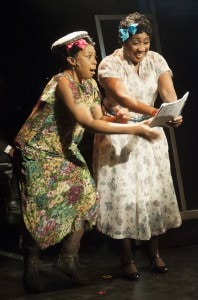The press opening performance of Ella Fitzgerald: First Lady of Song, conceived, directed, and choreographed by Maurice Hines, was a tour de force. I strongly recommend that anyone with an interest in early jazz, swing, be bop, Ella Fitzgerald, great vocals, or just having a great time in the theatre buy their tickets for this production immediately.

Briefly, this is the story of Fitzgerald’s life told mainly through song. It also contains brief dialogues and monologues by Ella (Freda Payne), young Ella/Frances (Wynonna Smith), and Georgiana, her cousin and companion throughout her career (Roz White). All three stars have stellar careers on Broadway, in national tours, stage and screen, and in the best regional theaters around the country. Freda Payne will release her 18th album in March. They all burn up the stage with their enormous vocal skills.
The cast is rounded out by the talented Tom Wiggen, who plays Norman Granz, the promoter and producer who passionately pursued the cause of opening audience admission to people of color before Fitzgerald would perform at their venues. Granz later boosted her career by recording songbooks of favorite american artists. An artist of many talents, Wiggen is probably most recognizable as Kirk Anderson in As the World Turns.
The band backing Ms. Payne and other cast members was tight, star-studded and, indeed, ‘out of this world.’ All have performed and recorded with familiar names including Count Basie, Aretha Franklin, Hank Jones, “Slide” Hanson, and Ray Charles, to name a few.
Pianist and Conductor William Knowles (piano and conductor) kept things swinging, be-bopping. and jazzed it up throughout the evening. He was joined by Gregg Holloway (drums), Grant Langford (sax), Doug Pierce (Trumpet) and Yusef Chisholm (bass). Chisholm also played a surly Ray Brown, Fitzgerald’s second husband. Man, they can swing!
Almost every song was a highlight of the evening. The audience explosively erupted with applause to “You’ve Changed,” “The Lady is a Tramp,” and “Mack the Knife.” Mr. Hines, sitting directly behind me, nearly leapt out of his seat for “Oh, Lady be Good.” Dick Gregory, just a few seats down from me appeared gleeful at every number. And local band leader, Daryl Davis, could hardly keep his head from bopping to the rhythms.
For some songs, applause showered down with the first notes; at other times, Ms. Payne’s endings were obscured by the racket created by the audience.
For me, scenes in which Ms. Fitzgerald and young Ella performed standing back-to-back or in mirror image held a fragile beauty.
The book, written by Lee Summers, was very informative, following each period of Fitzgerald’s career through the decades. Each period was marked by a major difficulty in Fitzgerald’s life, either a death of someone dear to her, like her sister Frances, or yet another divorce. Through it all, Fitzgerald continued to perform because it was the one thing that brought her solace and joy. Yet she never ended her unfulfilled longing for a special love.
Carl Gudenious’ effective set design focused on Fitzgerald’s singing career where she was backed by her band, either fully exposed, or seen through a screen – not unlike the ones used by singers in studios today. On either side of the stage sat two dressing tables, brilliant in their simplicity and different tone to contrast the Ella’s family and personal life from her professional career. Gudenious used two simple tables — and that is all, as the setting for telling the behind-the-scene story of Fitzgerald’s life. Most of the dialogue takes place at these two stations with important news delivered via one of the two telephones. In this production’s sets. Less and simple was more and quite effective.
With a play featuring music familiar to many, good sound design was critical and Robert Garner kept the mix just right and the focus on the actors. Lighting Designer Alexander Keen provided the simple and effective lighting, and William E. Crttenden, Jr.’s clever projections of era’s appropriate signs and pictures were projected above the band. They were very helpful by letting us know the time during Fitzgerald’s meteoric rise and sustained popularity being addressed in the specific scenes.

Costume Designer Scotty Sherman worked carefully to dress Fitzgerald down to the finest detail in the clothing of each era. Her most valuable comment to me was that the costumes, once well-researched, were fun. However, the padded suit used by Freda Payne, a naturally slim woman, was quite awkward. Sherman is another star who has worked in costuming for everything from the Metropolitan Opera to Jersey Boys, Madonna and, most recently, If/Then, which has a tryout at National Theatre here in DC.
Director Maurice Hines and Associate Director Mel Johnson, Jr. have assembled a marvelous cast and inspired them with a vision which, according to Mr. Hines’ comments after the performance, was ‘created in full.’
Run and buy tickets now to the scattingly entertaining Ella Fitzgerald: First Lady of Song. You will have a great toe-tappin’ time.
Running Time: Two hours, including one intermission.
Ella Fitzgerald: First Lady of Song plays through March 15, 2014 at MetroStage -, 1201 North Royal Street, Alexandria, VA. For tickets, call (703) 548-9044. or purchase them online





